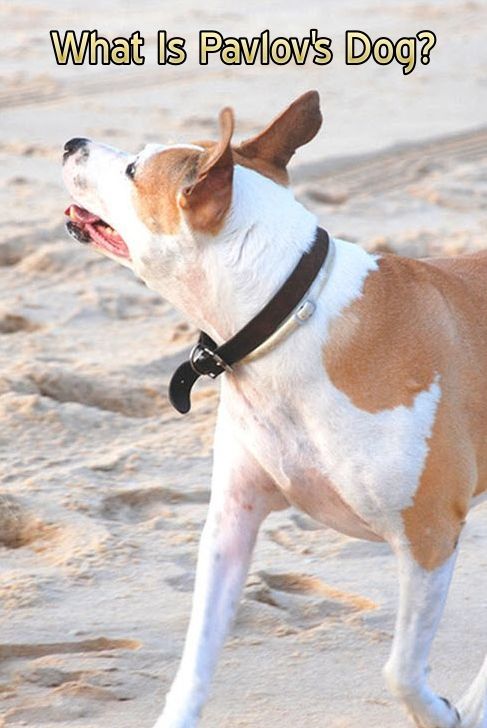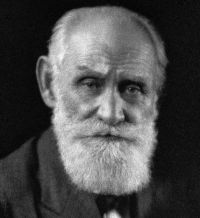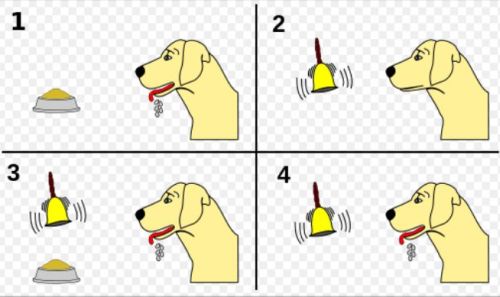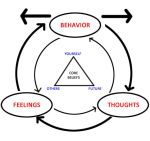Who was Ivan Pavlov?
Ivan Petrovitch Pavlov was a Russian physiologist (1849 – 1936) who won the Nobel Prize in 1904 for Physiology and Medicine. He was able to acquire this honor by studying digestion and salivary glands. Although his focus was on digestion, he accidentally stumbled across an important and fundamental process through which animals and humans learn.

Pavlov’s Accidental Discovery:
One day, Pavlov noticed a peculiar phenomenon. Not only did the dogs salivate when their food (meat powder) was brought into the room, but they also salivated whenever Pavlov or one of his assistants came into the  room. Pavlov became interested in why this was happening.
room. Pavlov became interested in why this was happening.
He set out to measure the saliva in these dogs by surgically implanting test tubes. His reasoning for this was to be able to get exact measurements of the saliva. Because salivation to the food appeared to be an unlearned reflex, it occurred to him that the dogs would salivate whenever they came in contact with an object or person that the dog associated with the food.
Pavlov’s Experiments with Pavlov’s Dog:
Pavlov began to run a series of experiments. He wanted to know if he could teach a dog to salivate to something or someone that did not typically cause salivation. “Conditioning,” in Pavlov’s world, is synonymous with “Learning.”
So in other words, if the dog did not have to “learn” to salivate to the food, then the food was an “unconditioned stimulus” or “something that produces an unlearned reaction or response.” The food is the “unconditioned stimulus” and the salivation is the “unconditioned response.” Remember – “unconditioned” means “unlearned.” Unlearned refers to something that is instinctual or reflexive.

Pavlov and his assistants started to bring a bell into the room with the dogs. They would ring the bell and measure the saliva. The result was that the bell did not cause the dog to salivate. Since the bell did not evoke a response, it was considered a “neutral” stimulus (or object.)
In the next stages of the experiment, Pavlov and his assistants began to ring the bell and then immediately following the ring, they would bring in the meat powder. After doing this repeatedly, they eventually rang the bell without bringing in the meat powder, and the dog started to salivate at the sound of the ringing bell only.
At this point, the bell now elicited a response or reaction (salivation) from the dog. So now the bell is the conditioned stimulus (learned object) that invoked a conditioned response (learned reaction – salivation.)

What Makes This Work:
After studying the time relationships, they discovered that this only worked if the bell was presented before the meat powder (during the learning process.) This was called forward conditioning. They also discovered that the pairing of the bell and the meat powder had to take place within a reasonably close time period. This became known as the Law of Temporal Contiguity.
What this means is that the neutral stimulus (the bell) became associated with the meat powder and caused the dog to anticipate the meat powder. This associated anticipation caused the learned (conditioned) response.
Described by Pavlov, the Process Looks Like This:
- UCS (unconditioned stimulus – meat powder) causes UCR (unconditioned response – salivation.)
- NS (neutral stimulus – bell) is paired with UCS (unconditioned stimulus – meat powder).
- The bell is then presented without the meat powder.
- Now the bell (CS – conditioned stimulus) causes (CR – conditioned response – learned salivation.)
How This Changed the Focus of Learning:
What this did was take the focus of learning away from the subjective and towards the objective, quantifiable (ability to be measured) physiological events. In other words, they were now able to measure the formation of an association or connection between a stimulus and a response.
Hopefully, This is Not Clear as Mud!
What this means is that an important discovery was made called Classical Conditioning, also known as Pavlovian or Respondent Conditioning. This demonstrated some important points – how behavior can be changed and how this association is necessary for learning to take place. It also proved that reinforcement increases the chances that an animal or human will respond.
What Pavlov’s Dog Demonstrated:
When the bell and the meat powder were paired together, salivation occurred and learning took place. This demonstrated that human beings and animals possessed higher-level processes of mental capacity. This caused more emphasis in psychology to be placed on objectivity in scientific methods and the corresponding subject matter.

It reinforced the idea that animals and humans were complicated machines and also reinforced the trend toward measurable, practical and objective applications of function in animals. This influenced John Watson, the founder of Behaviorism.
What Classical Conditioning Revealed About Animals and Humans:
Classical Conditioning Learning was the first systematic study of the laws of learning. It showed that animals and humans can be trained to behave and act a certain way. It also uncovered much mystery into the development of anxiety and phobias.
Because of this, it was used to treat phobias by pairing a feared stimulus with something that would invoke relaxation. This was called Systematic Desensitization. Another method used was called Extinction, and an example of this would be if the bell was consistently rung without the presence of meat powder until eventually the response was reversed because the learned condition was lessened and the connection became correspondently weakened.

Why Classical Conditioning Was Critical:
Classical Conditioning was extremely critical for being one of the fundamental discoveries of Learning Theory and a precursor to the dominating theory of Behaviorism that followed shortly afterward. To try and put this in simpler terms, this was critical to our understanding of how we learn and develop phobias.
This Gave Us Great Insight into Why People Do the Things They Do:
Suppose it is thundering and lightning outside. One person may find this to be relaxing because  they associate it with being able to take a day off from work and stay home and relax. Another person (or dog) may associate it with loud, explosive noises, blistering wind and being caught in uncomfortable weather.
they associate it with being able to take a day off from work and stay home and relax. Another person (or dog) may associate it with loud, explosive noises, blistering wind and being caught in uncomfortable weather.
In either case, it is the same stimulus but it invokes two different responses. One person associates it with an unpleasant experience and another person associates it with a pleasant experience. Can the person who associates it with an unpleasant experience be trained to desensitize themselves from the painful emotions? According to Classical Conditioning, the answer is yes!
How Pavlov’s Dog Has Been Helping People Ever Since:
So, as you can see, Pavlov’s dog was famous for a good reason! Because of Pavlov’s dog, many people have been able to successfully find relief from phobias. Many other people have developed better and easier ways for human beings to learn new information and unlearn something unpleasant!
To learn some of the most recent research about the mind and learning, you may want to click here.
Hopefully, you found this article helpful! Please share your experiences with Classical Conditioning in your life in the comments below! All comments are very much appreciated!





